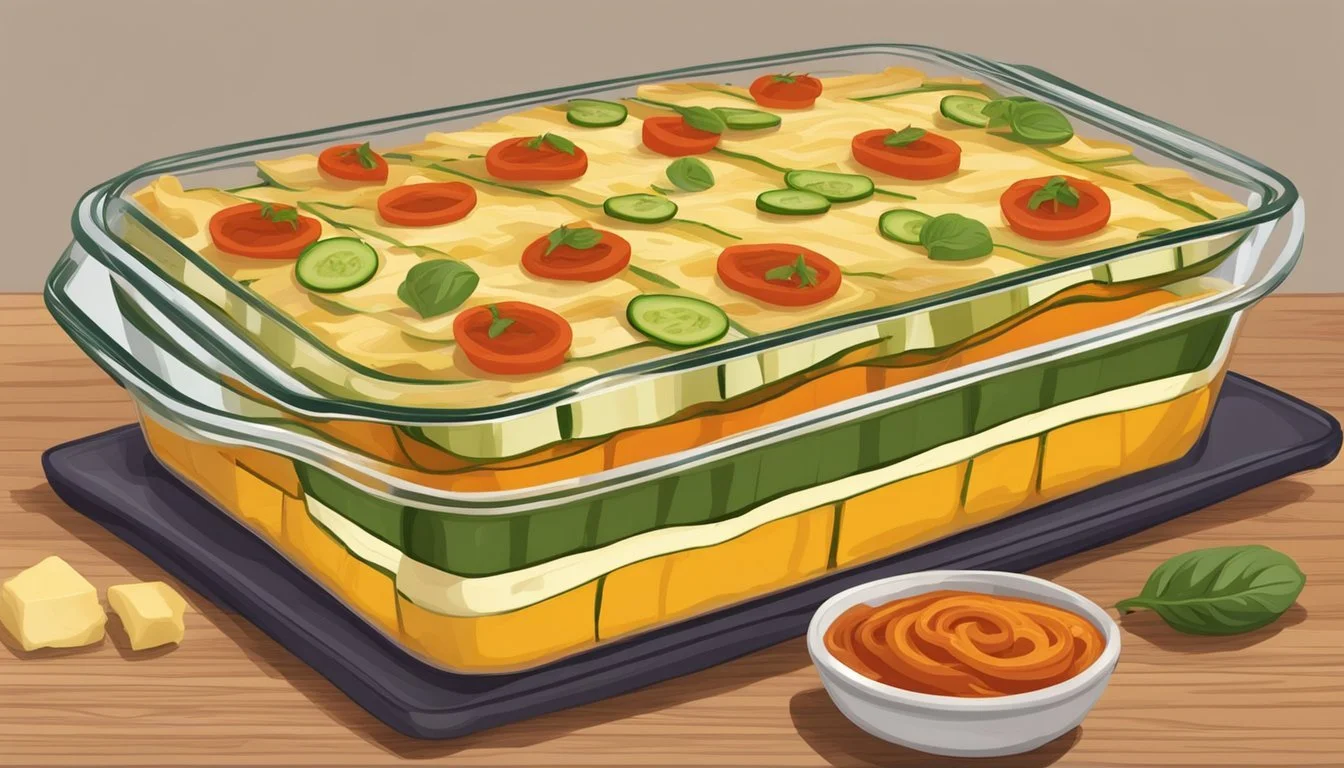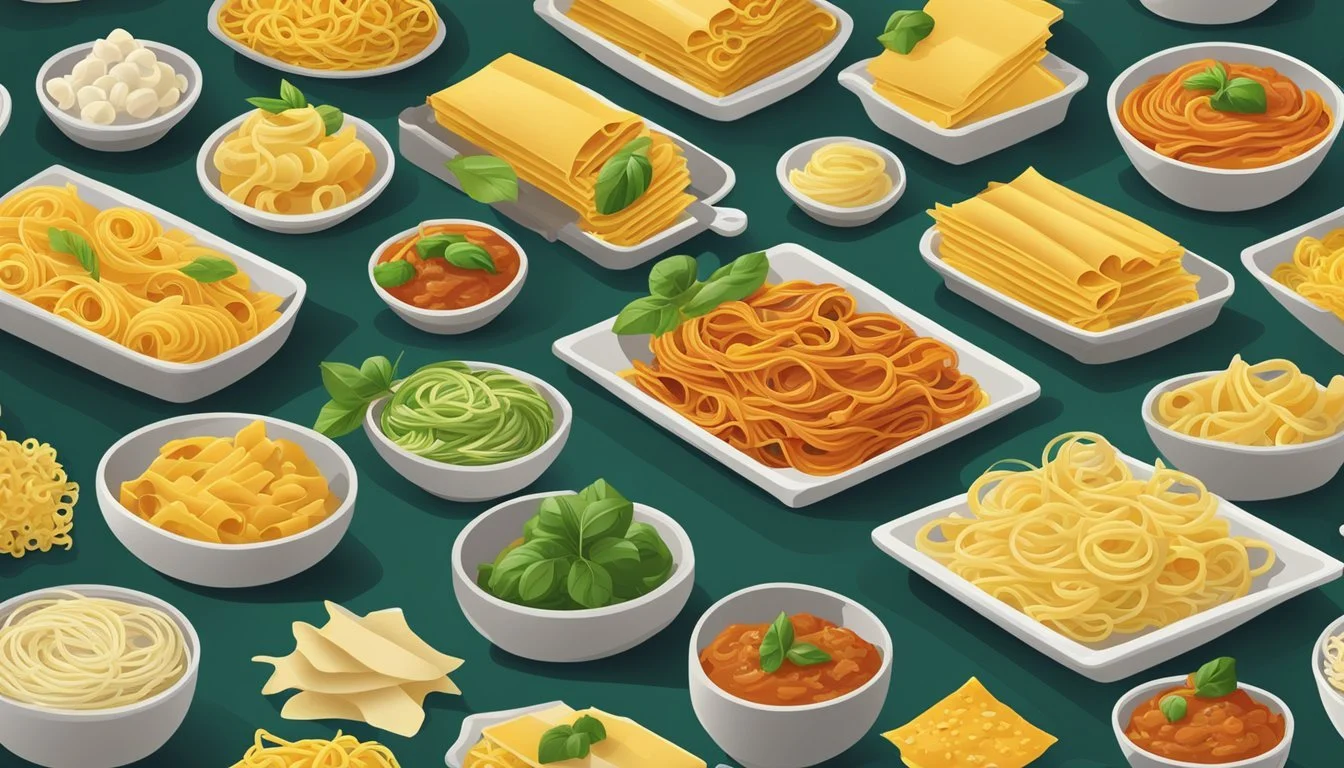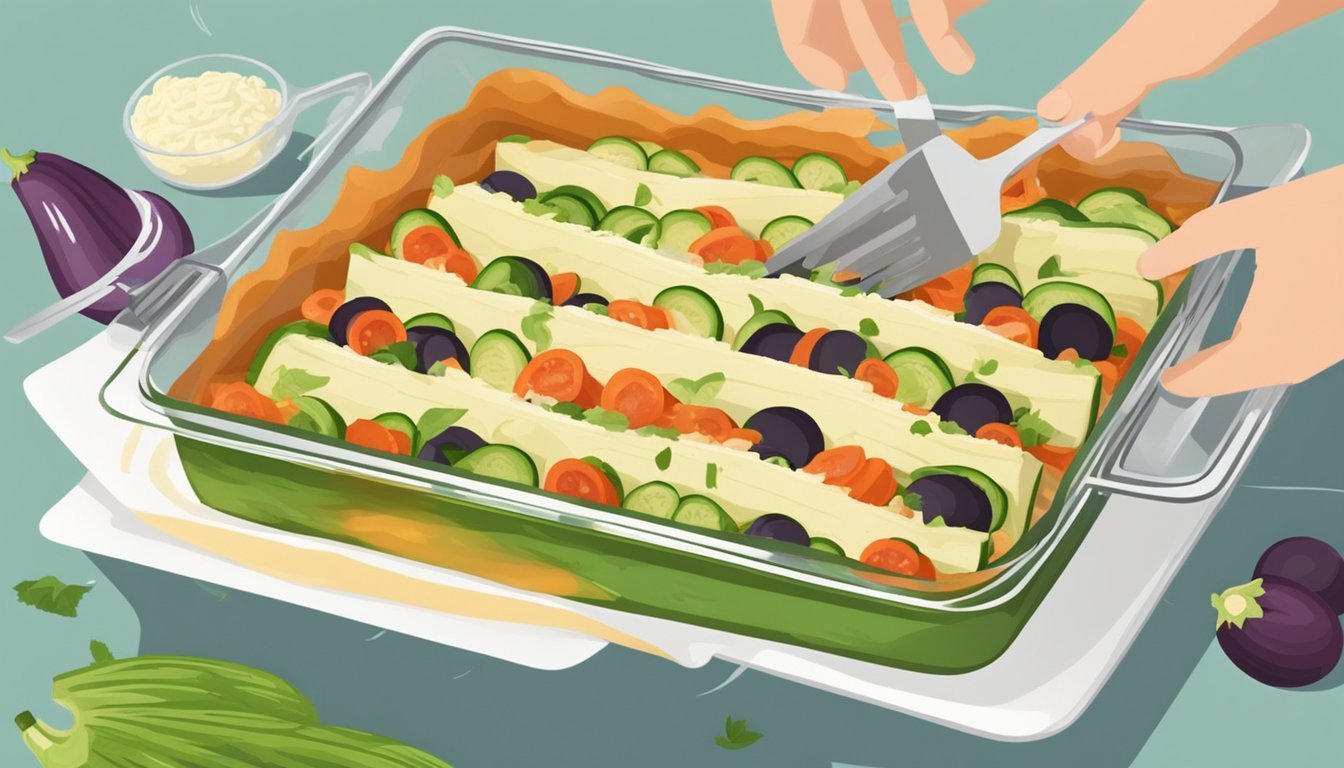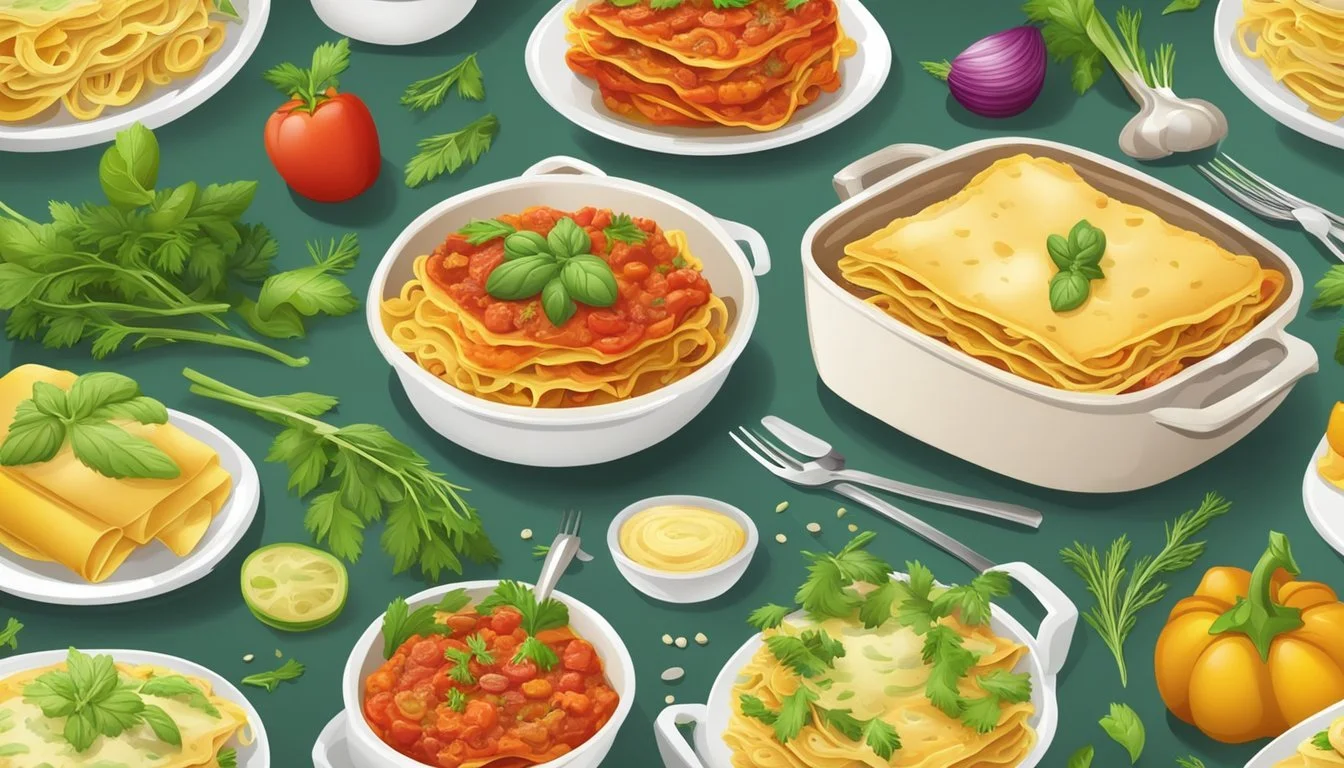Lasagna Pasta Substitutes
Top Alternatives for Traditional Recipes
Lasagna, a classic Italian dish, is traditionally made with layers of rich meat sauce, creamy béchamel, and wide sheets of pasta (What wine goes well with pasta?). However, the flexibility of lasagna allows for various pasta substitutes that cater to different dietary preferences and needs. Whether for health reasons, such as reducing carbohydrate intake or accommodating gluten intolerance, or simply for a twist on the conventional recipe, alternative options are plentiful and often integrate seamlessly into the dish.
Popular pasta substitutes include vegetables like zucchini strips and eggplant slices that provide not only a nutritious edge but also introduce new textures and flavors. Zucchini's firm yet tender consistency and mild taste make it a favorite among health enthusiasts, while eggplant offers a meatier texture with a slightly sweeter profile. Both vegetables can be cut into wide strips that mimic the shape of lasagna noodles and absorb sauces well, making for a satisfying and wholesome meal.
Beyond vegetables, some opt for other types of pasta such as fettuccine. Fettuccine's long, flat noodles are a closer match to lasagna's texture and are an easy swap in recipes. While the taste and feel of the dish remain largely unchanged, this simple change can make a difference to those who prefer the consistency of traditional pasta but need or want to experiment with different pasta shapes and sizes. As these alternatives become more commonplace, they enrich the culinary landscape with their unique qualities, bridging the gap between traditional comfort food and contemporary eating trends.
Understanding Lasagna Pasta
Lasagna pasta plays a pivotal role in the traditional Italian dish, lasagna. It is essential for the structural integrity and classic taste of the dish. This section will delve into the historical significance, the function of pasta within lasagna, and the nutritional aspects of traditional pasta.
History of Lasagna
Lasagna has its roots deep in the history of Italy, with variations dating back to Ancient Rome. The term "lasagna" originally referred to a cooking pot, but over time, it came to denote the dish prepared within it. Traditional lasagna pasta is made from durum wheat, making it robust enough to layer with rich sauces and fillings.
Role of Pasta in Lasagna
Pasta is the foundational element in lasagna, serving both functional and culinary purposes. It provides structure, dividing the dish into layers that support the melange of meat, cheese, and sauce. Each pasta layer absorbs flavors and contributes to a diversified texture when baked. Traditional pasta offers a hearty taste, while alternative noodles can modify the flavor profile and nutritional content.
Nutritional Profile of Pasta
Pasta is known for its high carbohydrate content, providing a primary source of energy. The nutritional profile of traditional wheat-based lasagna pasta typically includes:
Calories: Ranges between 200-300 per serving
Carbs: Approximately 40 grams per serving
Protein: Around 10 grams per serving
Fiber: Variable, based on whether it's white or whole-wheat pasta
Lasagna pasta can be gluten-rich due to its wheat origin. However, gluten-free pasta options are available for those with dietary restrictions, usually made from rice flour or legumes, providing a similar texture with a different nutritional breakdown.
Essential Substitutes for Lasagna Noodles
Finding the right substitute for traditional lasagna noodles can transform the dish into a healthier, lower-carb, or gluten-free meal without sacrificing flavor or texture.
Choosing the Right Substitute
When selecting a lasagna noodle substitute, consider the desired end result. For gluten-free diets, opt for a pasta alternative that complements the richness of the lasagna fillings. For a low-carb or keto-friendly dish, vegetables that mimic the shape and structure of lasagna sheets can be used.
Vegetable-Based Alternatives
Zucchini: Thinly sliced zucchini can replace pasta sheets, offering a low-carb, gluten-free, and vegetarian option. To avoid a watery lasagna, salt and drain the zucchini slices before use, or grill them to reduce moisture content.
Eggplant: Sliced eggplant provides a robust, slightly sweet flavor. To use it as a substitute, fry sliced eggplant to golden brown, which will ensure a firmer texture in the final dish.
Cauliflower: Cauliflower can be used to create a lasagna with a distinct texture and subtle flavor. Processed into small pieces and prepared properly, it can be a base for a gluten-free lasagna layer.
Butternut Squash: This sweet-flavored vegetable can be sliced into thin sheets to create a nutrient-rich, gluten-free lasagna layer.
Spaghetti Squash: Once baked and shredded, spaghetti squash forms noodle-like strands that can act as a low-carb, gluten-free layer in lasagna.
Gluten-Free Options
For those avoiding gluten, besides vegetable substitutes, look for pasta alternatives made from:
Rice flour
Corn flour
A blend of gluten-free grains
Make sure to check if these pasta alternatives require precooking before layering them into your lasagna.
Low-Carb and Keto-Friendly Substitutes
For a keto-friendly lasagna, focus on substitutes high in fiber but low in carbohydrates.
Zucchini Noodles (Zoodles): Spiralized zucchini provides a pasta-like experience with a fraction of the carbs.
Other Spiralized Vegetables: Consider spiralizing vegetables like butternut squash or other squash varieties for diverse flavors and textures.
Incorporating these substitutes into a lasagna dish can help accommodate various dietary needs while keeping the meal enjoyable and satisfying.
Cooking with Lasagna Substitutes
When one opts for alternatives to traditional lasagna noodles, there are specific techniques to ensure that the dish retains its beloved texture and flavor. These approaches, from preparation to baking, can vary depending on the chosen substitute.
Preparation Techniques
Before substituting lasagna noodles, it's essential to understand the nuances of preparing alternative ingredients. Fettuccine, resembling lasagna sheets in size and shape, should be cooked until al dente to keep its structure in the layered dish. When using vegetables like zucchini strips or eggplant slices, a mandoline or spiralizer can help achieve uniform thinness. These slices benefit from pre-cooking to remove excess moisture—a crucial step to prevent a watery lasagna. For instance, zucchini might be seasoned with salt and olive oil and sautéed briefly to enhance flavor while maintaining a slight crunch.
Baking Considerations
Substitutes should be layered as standard lasagna noodles and paired with ample sauces, cheeses, and other fillings to bind the layers. As they bake, substitutions can alter cooking times. Vegetables, with higher water content, often require a longer bake to achieve the desired consistency, whereas pasta alternatives like fettuccine may need a shorter time in the oven compared to traditional lasagna noodles. The key is to monitor the dish for signs of golden cheese and crisped edges without drying out the middle.
Maintaining Texture and Flavor
Selection of a lasagna substitute should not only consider nutritional benefits or dietary restrictions but also how it complements the classic lasagna flavors of herbs, spices, and seasoning. Vegetables with a more neutral flavor are preferable, as they allow the authentic lasagna taste profile to stand out. Post-baking, it's critical to let the lasagna rest, allowing layers to set and flavors to meld. Butter, herbs, or an infused olive oil drizzle might be utilized for added richness or to elevate the overall taste of the substitution, ensuring a familiar, yet unique lasagna experience.
Complementary Ingredients and Pairings
Selecting the right ingredients to complement and pair with lasagna pasta substitutes can elevate the dish. Substitutions not only pertain to noodles but also to cheese, proteins, and sauces that enhance flavor and texture.
Cheese and Dairy Alternatives
Cheese is a central ingredient in lasagna, providing creamy richness. For those seeking dairy-free options, vegan cheese alternatives made from nuts or soy can be used. Mozzarella and ricotta cheese are traditional choices, with mozzarella offering a melty texture and ricotta providing a creamy layer. Parmesan cheese, with its rich umami flavor, can be grated on top for a bold finish.
Traditional Cheese Options:
Mozzarella (for meltiness)
Ricotta Cheese (for creaminess)
Parmesan Cheese (for a flavor kick)
Vegan Alternatives:
Nutritional yeast (for a cheesy flavor)
Vegan mozzarella (for a similar melt)
Meat and Plant-Based Proteins
Lasagna benefits from the addition of protein which can vary from ground beef for a classic meaty flavor, to mushrooms which offer an earthy and meaty texture suitable for vegetarian versions. Eggplant slices can also serve as a flavorful and robust substitute rich in fiber, while spinach adds a nutritional boost and complements both meat and plant-based proteins.
Meat Options:
Ground Beef (classic choice)
Italian Sausage (for spicier notes)
Plant-Based Proteins:
Mushrooms (meaty texture)
Eggplant slices (hearty structure)
Spinach (nutrient-rich)
Sauces and Enhancements
The sauce of the lasagna binds all the ingredients together and profoundly impacts the overall flavor of the dish. A robust tomato sauce, infused with garlic and onions simmered in olive oil, serves as a classic base. For an enhanced experience, one can include a variety of vegetables like tomatoes or spinach to add both flavor and nutrients. These additions can provide depth and complexity to the lasagna's profile.
Base Sauce Components:
Tomatoes (fresh or canned)
Garlic and Onion (for foundational flavors)
Olive Oil (for sautéing)
Enhancements:
Fresh herbs (basil or oregano)
Red pepper flakes (for heat)
Vegetables like carrots or zucchini (for texture and sweetness)
Health and Dietary Considerations
Choosing pasta substitutes often stems from a desire to adhere to specific dietary needs or to improve overall health. Substitutes can offer lower calories and carbs, as well as gluten-free options, while still providing essential nutrients.
Benefits of Pasta Substitutes
Pasta substitutes can be beneficial as they often contain more fiber and a variety of vitamins and minerals. Vegetables like zucchini or cabbage, when used as noodle replacements, add valuable antioxidants to the meal, enhancing its nutritional profile. Additionally, whole grains like brown rice and quinoa provide protein and fiber without the gluten found in traditional pasta.
Managing Caloric Intake
Substitutes for traditional pasta are frequently sought out for their low-calorie benefits. For instance, zucchini strips, a popular noodle alternative, have significantly fewer calories and carbs than their wheat-based counterparts. This makes them an excellent choice for weight management and for those monitoring their caloric consumption.
Allergen-Free Options
For individuals with dietary restrictions, gluten-free and allergen-free alternatives are crucial. Options like brown rice and quinoa fusilli are not only gluten-free, but also cater to vegan and vegetarian diets. Substitutes such as these ensure that everyone has the opportunity to enjoy a lasagna-like experience, regardless of dietary constraints, while often adding beneficial nutrients like iron and fiber to one's diet.
Creative Alternatives Beyond Vegetables
While vegetables like zucchini or eggplant are go-to substitutes for lasagna noodles, one can also explore diverse grains and innovative pasta types for a unique spin on traditional lasagna.
Grain and Legume Options
Grains like quinoa and barley serve as hearty substitutes for lasagna noodles, lending a nutty flavor and chewy texture to the dish. One can use them as layers or mix them in with the lasagna's filling. Quinoa, in particular, is a gluten-free option that adds protein to the lasagna.
Rice noodles: Offer a gluten-free alternative, especially fitting for a lasagna with an Asian twist.
Legumes provide another dimension altogether:
Fettuccine made from lentils or chickpeas: These mimic traditional pasta's texture while offering higher protein content and a lower glycemic index, making them a smart choice for health-conscious cooks.
Innovative Pasta Alternatives
Looking at non-traditional pasta types can open up a world of possibilities:
Shirataki noodles: Made from the konjac yam, they are almost zero-calorie and extremely low in carbs, ideal for those on ketogenic diets.
Egg noodles: Thicker and more substantial, which can hold up to the rich sauces and cheeses in lasagna.
Other pasta shapes can surprisingly fit into a lasagna recipe:
Manicotti
Farfalle
Penne pasta
Their use requires a bit of creativity in assembly, but they can introduce interesting textures and layers in a lasagna dish. For instance:
Pasta Type Preparation Notes Manicotti Can be stuffed and layered similarly to traditional lasagna noodles. Farfalle Provides a unique visual and textural experience when layered in a dish. Penne Pasta Can be stood on end or layered horizontally for a different take on lasagna layers.
Substituting traditional lasagna noodles for other types of pasta like spaghetti or fettuccine is also a simple change that maintains the spirit of the dish while offering a different mouthfeel and twist on the classic.
Lasagna Assembly and Presentation
The lasagna assembly is a process of layering various components to achieve a harmonious blend of flavors and textures, which is further complemented by its presentation that entices the diner.
Layering Components
For a successful lasagna, the chef begins with a base layer often consisting of a savory meat sauce to provide a solid foundation. Subsequent layering involves alternating between the chosen pasta substitute, like zucchini strips or eggplant slices, and a rich, cheesy sauce. A typical cheese mixture may include a well-seasoned blend of ricotta cheese, shredded mozzarella, and grated parmesan cheese, often enhanced with chopped herbs and spices for added flavor. The order and technique of layering are crucial for ensuring that each bite of lasagna contains a balance of ingredients.
First Layer: Meat sauce
Second Layer: Pasta substitute (e.g., zucchini strips or eggplant slices)
Third Layer: Cheesy sauce mixture (ricotta, mozzarella, parmesan, herbs, spices)
Repeat the sequence, ensuring sauce covers the vegetables thoroughly
Final Touches for Serving
Prior to serving, the lasagna requires a final layer of mozzarella and parmesan cheese to create a golden, appetizing crust when baked. Upon completion of the baking period, the lasagna should rest to allow for easier slicing and to maintain its structural integrity on the plate. Garnishes of fresh herbs like basil or parsley add a visual and flavorful enhancement to each serving, underscoring the layers and the meticulous preparation of the lasagna.
Top Layer: Additional mozzarella and parmesan cheese
Resting Time: Allow lasagna to set before serving
Garnish: Fresh herbs (basil, parsley)
Presentation is about visual appeal as much as taste, with neatly defined layers and an inviting golden top crucial to the diner's first impression.
Adapting Traditional Recipes
Adapting traditional lasagna recipes to accommodate dietary preferences or cultural variations can invigorate this Italian classic with new flavors and textures. Whether through necessity or creativity, substitutes for lasagna noodles and modifications in the cheese layers can result in delightful vegetarian, vegan, or culturally-inspired dishes.
Vegan and Vegetarian Variations
In vegetarian lasagna, traditional meat layers are often replaced with a variety of vegetables such as zucchini, spinach, or mushrooms. Zucchini strips, when thinly sliced, serve as a low-carb substitute for lasagna noodles, offering a crunchy texture and a hint of sweetness that complements tomato-based sauces. For a vegan twist, cheese alternatives must be considered. Instead of ricotta cheese, one might opt for cashew cheese or tofu blends seasoned with nutritional yeast to mimic the rich flavor of Parmesan.
Substitutes for Lasagna Noodles in Vegetarian Lasagna:
Zucchini strips
Thinly sliced eggplant
Pre-cooked fettuccine or other ribbon pasta
Vegan Cheese Alternatives:
Cashew cheese
Tofu ricotta (tofu, nutritional yeast, lemon juice)
Store-bought vegan mozzarella or parmesan
Cultural Twists on Lasagna
Exploring cultural variations, chefs might incorporate ingredients that reflect different cuisines. For instance, a Mexican-inspired lasagna could include layers of corn tortillas in place of pasta, paired with ingredients like black beans, corn, and a salsa verde. An Asian fusion version could involve rice noodles with a spicy peanut sauce and a blend of stir-fried vegetables. Always mindful of the core components, substitutes for lasagna noodles in these cultural twists can still align with Italian cuisine's emphasis on layering and robust flavors.
Ingredients for Cultural Lasagna Variations:
Mexican-Style: Corn tortillas, black beans, corn, salsa verde, cheddar cheese
Asian Fusion: Rice noodles, peanut sauce, stir-fried bell peppers, carrots, and tofu
Whether catering to dietary preferences or expanding the culinary horizons of traditional lasagne, the versatility of this Italian dish allows an endless array of creative adaptations.
Additional Tips and Tricks
When working with lasagna substitutes, it's essential to handle leftovers correctly and have rapid solutions for meals without compromising flavor or texture.
Storing Leftovers
Proper storage is vital to retain the lasagna's quality. Leftovers should be stored in airtight containers and refrigerated within two hours of cooking to maintain freshness. Lasagna retains its best quality for 3-5 days in the refrigerator. For freezing, wrap the lasagna tightly with aluminum foil or freezer wrap, or place it in a heavy-duty freezer bag.
Refrigeration: Up to 5 days in an airtight container.
Freezing: Best used within 2-3 months.
When reheating, adding a sprinkle of water can help to moisten the pasta and prevent it from drying out. A drizzle of olive oil before reheating will keep the cheese from hardening and enhance the flavor with its richness.
Quick Meal Solutions
For those short on time, preparing lasagna with no-boil noodles can be a game-changer. One can also double the sauce or add a cup of water to the recipe when using no-boil noodles to ensure they cook properly.
No-Boil Noodles: Double the sauce or add one cup of water.
Pre-Mixed Seasoning: Prepare a blend of herbs and spices in advance to speed up the cooking process.
Incorporate seasoning directly into the cheese mixture, which typically includes ricotta cheese, mozzarella cheese, parmesan cheese, and a beaten egg along with herbs such as basil and parsley. This not only infuses the layers with flavors but also saves time.
Conclusion
When considering substitutes for lasagna pasta, there is a wealth of alternatives that cater to different dietary preferences and requirements. Fettuccine has been identified as a suitable replacement due to its similar size and shape, making it a straightforward swap in a traditional lasagna recipe.
For those looking to reduce carbohydrates or calories, zucchini strips offer a vegetable-based option that maintains the structural integrity of the dish. Their slightly sweet flavor and crunchy texture can enhance the lasagna while aligning with health-conscious goals. Prepared properly, zucchini can act as a suitable low-carbohydrate substitute without compromising on the dish's texture or flavor.
It should be noted that when using any pasta alternative, one must adjust cooking techniques accordingly. Adequate cooking ensures that the substitutes not only mimic the consistency of traditional lasagna noodles but also absorb the sauce effectively to achieve the desired culinary result.
These substitutes empower cooks with the flexibility to adapt classic lasagna to various dietary needs without sacrificing the essence of this beloved dish. The ability to swap pasta for other ingredients with confidence broadens the appeal of lasagna, making it more inclusive for diverse palates and nutritional guidelines.
In summary, the suitable selection and preparation of pasta substitutes can uphold the integrity of a classic lasagna, providing a satisfying and enjoyable experience for all diners.










